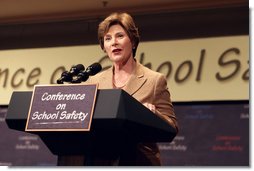|
Home >
News & Policies >
October 2006
|
For Immediate Release
Office of the First Lady
October 10, 2006
Mrs. Bush's Remarks at a Conference on School Safety
National 4-H Youth Conference Center
Chevy Chase, Maryland
11:57 A.M. EDT
MRS. BUSH: Thank you, Secretary Spellings. I want to recognize our Attorney General, Alberto Gonzales. Good to see you here. I understand the Lieutenant Governor from Colorado is here, as well, the Honorable Jane Norton. Thank you for joining us.
Parents, teachers, school officials, law enforcement officers, community leaders -- thank you all very, very much for joining us today for this very important discussion for our country.
 The recent school shootings in Colorado and Wisconsin and Pennsylvania
are terrible tragedies. The communities affected by these attacks, and
all Americans who have been devastated by school violence, have the
support and the prayers of families across our country.
The recent school shootings in Colorado and Wisconsin and Pennsylvania
are terrible tragedies. The communities affected by these attacks, and
all Americans who have been devastated by school violence, have the
support and the prayers of families across our country.
Today, we've gathered to discuss how the federal government, local governments and community leaders can prevent similar attacks, and help comfort the victims of shootings that have just occurred.
For those who have experienced the trauma of school violence, especially children, healing will require the support and the care of many people. Parents, grandparents, teachers, school counselors, coaches and pastors must listen to children's concerns, reassure young people that they're loved, and let them know that grownups are working to protect them.
Acts of school violence are not isolated incidents. Reports of one school shooting can disturb children and teachers in classrooms around the country. Children can't learn if they're worried about their safety, which is why adults must do everything they can to reassure children through their own actions.
When young people see grownups going about their lives with confidence, they'll draw strength from the adults' example. Activities like preparedness drills help ease children's fears of a possible attack by giving them the knowledge they need to protect themselves if one should occur.
And as we saw in the aftermath of September 11th and Hurricane Katrina, children who have endured trauma heal best when chaos is replaced with the normalcy and the comfort of their familiar routine, both at home and at school.
But the best way to ease children's fears about their safety is to reduce the threat of violence in their classrooms. To secure our schools, we must address the underlying causes of school violence, including violent tendencies throughout our culture.
One of the best ways to keep Americans away from violent behavior, both as young people and adults, is to give our children a more positive vision for their future. Young people who have hope for healthy and successful lives are less likely to engage in dangerous behavior that will put their lives at risk.
In his 2005 State of the Union address, President Bush announced the Helping America's Youth Initiative that Margaret just told you about, and he asked me to lead it. Guiding young people as they build the knowledge and the self-respect they need to lead successful lives is at the heart of Helping America's Youth.
Over the last year and a half, I've traveled around our country, visiting with young people and with the adults who are so important to their lives. I've been to schools and to after-school programs. I've met with mentors and Big Brothers and Big Sisters. I've visited a sports program in Detroit, a debate program in Atlanta, and fatherhood initiatives in Kansas City and Milwaukee. I've visited gang intervention programs. I've visited violence prevention programs, including one that's represented here today, CeaseFire Chicago, which brings together entire communities -- clergy, neighbors, school administrators and local law enforcement -- to support young people as they leave gangs or leave the streets and find jobs.
On each of these visits, the young people I met with told me how important it is to know that there are adults who care about them, who understand the challenges they face, and who are interested in their lives.
More adults must invest in the lives of young people, because when adults believe in children, children learn to believe in themselves.
Last October, at the White House Conference on Helping America's Youth, we introduced an online, interactive Community Guide. The guide helps concerned adults learn more about the problems facing youth in your own communities. You can actually put it on your own community and see what your problems are, and you can also see what local resources you have to address those problems.
As Secretary Spellings mentioned, the Community Guide is available at www.helpingamericasyouth.gov -- that's g-o-v. I encourage you to look at the website and to use these resources in your home communities.
School violence is devastating, for the communities it affects and for young people throughout our country. The most recent school attacks have saddened and troubled all Americans. Yet these tragedies have also shown the best in our country. We saw tremendous courage in the Amish girls who, in the face of immediate danger, thought first of the safety of their younger schoolmates. And we've seen great resilience in the communities that have suffered such tragedies.
I urge all adults across the country to take their responsibility to children -- their own children and their community's children -- seriously. With time and attention, adults will keep children safe in our nation's schools, and build a more peaceful society for our country.
Thanks to each and every one of you for coming today, and thank you for supporting this vital work. Thank you for your commitment to young people. (Applause.)
END 12:04 P.M. EDT


